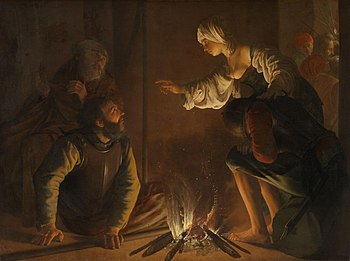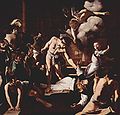
Baroque painting is the painting associated with the Baroque cultural movement. The movement is often identified with Absolutism, the Counter Reformation and Catholic Revival, but the existence of important Baroque art and architecture in non-absolutist and Protestant states throughout Western Europe underscores its widespread popularity.

Annibale Carracci was an Italian painter and instructor, active in Bologna and later in Rome. Along with his brother and cousin, Annibale was one of the progenitors, if not founders of a leading strand of the Baroque style, borrowing from styles from both north and south of their native city, and aspiring for a return to classical monumentality, but adding a more vital dynamism. Painters working under Annibale at the gallery of the Palazzo Farnese would be highly influential in Roman painting for decades.
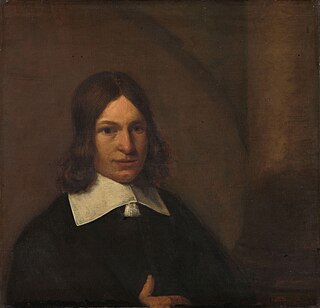
Pieter Hendricksz. de Hooch, was a Dutch Golden Age painter famous for his genre works of quiet domestic scenes with an open doorway. He was a contemporary, in the Delft Guild of St. Luke, of Jan Vermeer with whom his work shares themes and style. De Hooch was first recorded in Delft on 5 August 1652, when he and another painter, Hendrick van der Burgh witnessed the signing of a will. He was active in 1683, but his date of death is unknown.
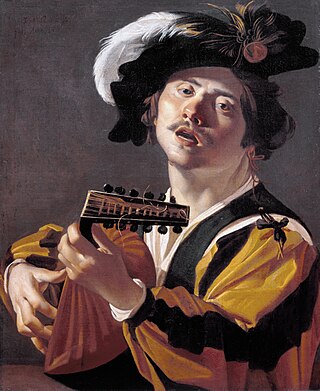
Dirck Jaspersz. van Baburen was a Dutch painter and one of the Utrecht Caravaggisti.

The Caravaggisti were stylistic followers of the late 16th-century Italian Baroque painter Caravaggio. His influence on the new Baroque style that eventually emerged from Mannerism was profound. Caravaggio never established a workshop as most other painters did, and thus had no school to spread his techniques. Nor did he ever set out his underlying philosophical approach to art, the psychological realism which can only be deduced from his surviving work. But it can be seen directly or indirectly in the work of Rubens, Jusepe de Ribera, Bernini, and Rembrandt. Famous while he lived, Caravaggio himself was forgotten almost immediately after his death. Many of his paintings were re-ascribed to his followers, such as The Taking of Christ, which was attributed to the Dutch painter Gerrit van Honthorst until 1990.

Abraham Bloemaert was a Dutch painter and printmaker who used etching and engraving. He initially worked in the style of the "Haarlem Mannerists", but by the beginning of the 17th-century altered his style in line with the new Baroque style that was then developing. He mostly painted history subjects and some landscapes. He was an important teacher, who trained most of the Utrecht Caravaggisti.

Utrecht Caravaggism refers to the work of a group of artists who were from, or had studied in, the Dutch city of Utrecht, and during their stay in Rome during the early seventeenth century had become distinctly influenced by the art of Caravaggio. Upon their return to the Dutch Republic, they worked in a so-called Caravaggist style, which in turn influenced an earlier generation of local artists as well as artists in Flanders. The key figures in the movement were Hendrick ter Brugghen, Gerrit van Honthorst and Dirck van Baburen, who introduced Caravaggism into Utrecht painting around 1620. After 1630 the artists moved in other directions and the movement petered out. The Utrecht Caravaggisti painted predominantly history scenes and genre scenes executed in a realist style.

Hendrick Jansz ter Brugghen was a Dutch painter of genre scenes and religious subjects. He was one of the Dutch followers of Caravaggio – the so-called Utrecht Caravaggisti. Along with Gerrit van Hondhorst and Dirck van Baburen, Ter Brugghen was one of the most important Dutch painters to have been influenced by Caravaggio.

The Calling of Saint Matthew is an oil painting by Caravaggio that depicts the moment Jesus Christ calls on the tax collector Matthew to follow him. It was completed in 1599–1600 for the Contarelli Chapel in the church of the French congregation, San Luigi dei Francesi in Rome, where it remains. It hangs alongside two other paintings of Matthew by Caravaggio: The Martyrdom of Saint Matthew and The Inspiration of Saint Matthew (1602).

Francesco Maria del Monte, full name Francesco Maria Bourbon del Monte Santa Maria, was an Italian cardinal, diplomat, and connoisseur of the arts. His fame today rests on his early patronage of the important Baroque master Caravaggio, and on his art collection which provides provenance for many important works of the period.
Events from the year 1629 in art.

The Crucifixion with the Virgin and St John by Hendrick ter Brugghen is an oil painting, now in the Metropolitan Museum of Art in New York City. It was probably painted c. 1625 as an altarpiece for a Catholic schuilkerk, a "hidden church" or "church in the attic", in the Calvinist Dutch United Provinces, probably Utrecht. When discovered in a bombed out church in South Hackney, London in 1956, it was unknown, but by the time it appeared in Sotheby's salesroom in November of that year it was recognized as an important example of Utrecht Caravaggism. It was acquired by the museum in the sale.
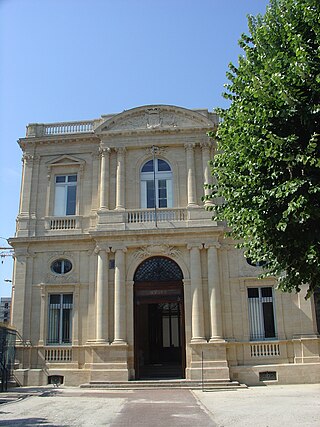
The Musée des Beaux-Arts de Bordeaux is the fine-art museum of the city of Bordeaux, France. The museum is housed in a dependency of the Palais Rohan in central Bordeaux. Its collections include paintings, sculptures and drawings from the 15th century to the 20th century. The largest collection is composed of paintings, and its strong points are works by French, Flemish painters and Dutch painters.

The Lute Player is an oil-on-canvas painting from 1623 or 1624 now in the Louvre by the Haarlem painter Frans Hals, showing a smiling actor wearing a jester's costume and playing a lute.
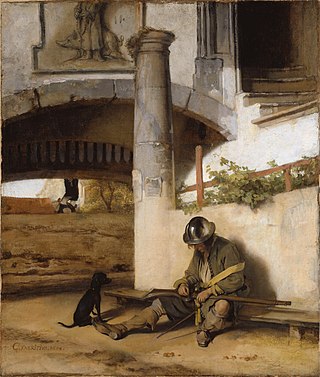
The Sentry is an oil-on-canvas painting by Dutch artist Carel Fabritius, created in 1654. Its dimensions are 68 by 58 cm. The work is in the collection of the Staatliches Museum in Schwerin. It represents a resting sentry and a dog.

Saint Sebastian Tended by Irene is an oil-on-canvas painting by Hendrick ter Brugghen dated to 1625. Now in the Allen Memorial Art Museum of Oberlin, Ohio, the piece depicts the Roman Catholic subject of Saint Sebastian Tended by Saint Irene, after Irene of Rome and her maid rescued him following his attempted martyrdom by the Roman authorities. An exemplary piece of the Italianate Baroque tendency in Dutch Golden Age painting, the painting employs dramatic uses of light and skillful chiaroscuro to depict its religious subject, evidence of influence from Caravaggio and Ter Brugghen's fellow Utrecht Caravaggisti.
The Denial of Saint Peter may refer to:
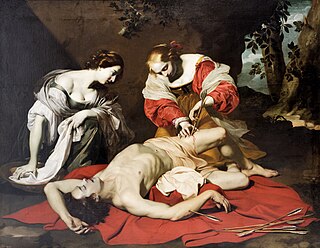
Saint Sebastian Tended by Saint Irene is an incident in the legends of Saint Sebastian and Saint Irene of Rome. It was not prominent in the hagiographical literature until the late Renaissance, and is hardly seen in art before then. As an artistic subject, normally in painting, it suddenly became popular from the 1610s, though found in predella scenes as early as the 15th century, and was most popular until about the 1670s.

The Incredulity of Saint Thomas is an oil painting on canvas by Matthias Stom, created c. 1640-1649. It is held in the Museo del Prado, in Madrid.
Gero Seelig is a German art historian and curator based in Schwerin, Germany. He is the Old Masters Curator at the Staatliches Museum Schwerin, in Schwerin, where he has worked since 2001. He is specialized in German and Dutch artists from the sixteenth and seventeenth centuries and has published extensively on prints, drawings, and paintings from these periods.
